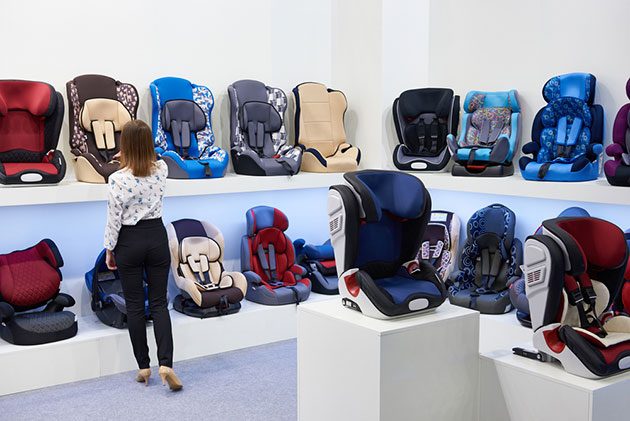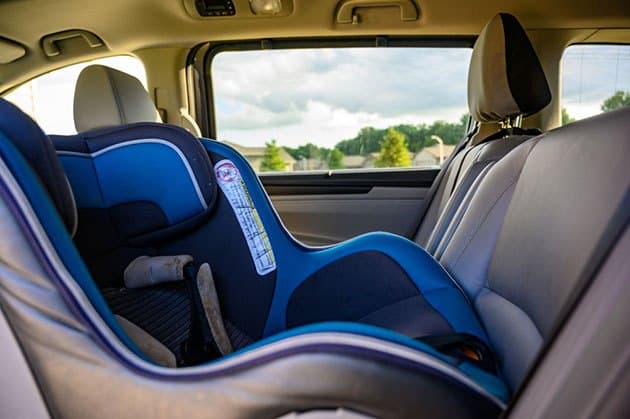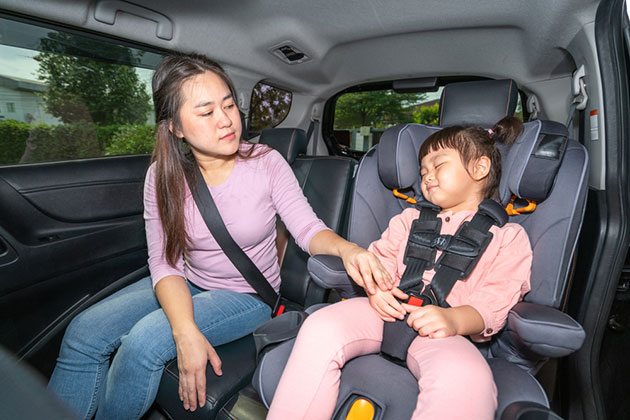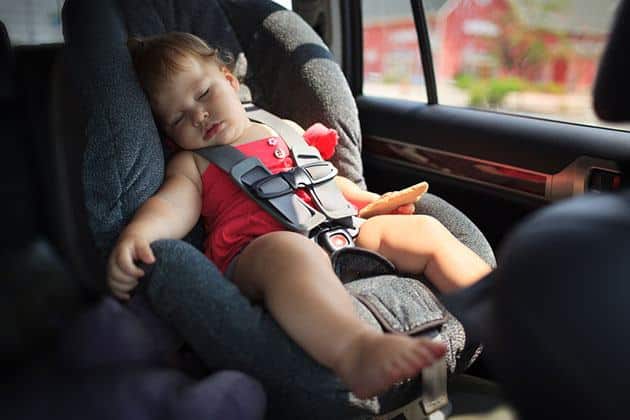Car seats are a must-buy when you are expecting a baby.
As soon as your baby starts using the infant car seat, you need to consider purchasing a car seat for the next stage. Babies grow rapidly; before you know it, it's time to use a convertible car seat.
Most parents often find themselves wondering:
When to switch to convertible car seat?
While both infant and convertible car seats are good transport options, they are only safe if used properly. This article covers all the essential facts & proper use of convertible and infant seats.
More...
What Are the Differences Between Infant Car Seats & Convertible Car Seats?
An infant car seat can be used from birth until your baby reaches the maximum weight limit, which is usually around their first birthday. A convertible car seat can often be used from birth to preschool, depending on the type of model you choose.
Regarding installation, an infant seat can be used only in the rear-facing position, while a convertible offers a rear-facing, forward-facing, and booster mode too!
The convertible seat is much heavier and bulkier for smaller cars than infant car seats. Once a convertible car seat is installed, it’s meant to stay in the car. Although portability is not the best side of convertible seats, their long-term use should not be ignored.
Both infant car seats and convertibles include a five-point harness for maximum safety. However, one of the biggest differences between infants and convertibles is stroller compatibility. Only infant car seats can be attached to strollers, while convertible seats are not suitable for this option.

Infant Car Seat
An infant car seat is a rear-facing child safety restraint system with a five-point harness. This car seat is designed for infants and newborns only, and it's required in all states.
Typically, rear-facing infant car seats are installed with a car seat base. The base allows for easier and more secure seat installation and makes unloading much more effortless. With the addition of carrying handles, parents can carry the car seat from vehicle to house without disrupting the baby's sleep.
Besides the mandatory five-point harness, infant seats also include an infant insert. The insert supports newborns from birth up until they reach 15 pounds. In addition, all infant car seats have several recline angles to offer the safest ride for your newborn.
Convertible Car Seat

A convertible car seat is a five-point harness seat with both rear-facing and forward-facing installations. At first, the convertible car seat is installed in a rear-facing position. However, as soon as the baby outgrows the rear-facing limits, it's time to convert the seat to a forward-facing position.
Some convertible car seats are called "all-in-one" seats, which accommodate more than two riding positions. Many parents opt for an all-in-one convertible they can use from birth to preschool.
The rear-facing convertible car seat usually has a weight limit of 40 pounds, while the forward-facing limit reaches 65 pounds. Due to the larger height and weight limit, convertible seats are preferred for bigger babies and tall toddlers.
How Long Are Infant Seats Good for?
Infant car seats are good for as long as your child reaches or exceeds these two criteria:
- The maximum height limits of 30-32 inches.
- The maximum weight limit of 30-35 lbs.
Considering each infant car seat has a different height or weight limit, it's best to check the manufacturer's label on the car seat of your choice.
Every car seat, including infant seats, has an expiration date. Usually, manufacturers set the date of expiry to six years. After the expiration date, it's no longer safe to use the car seat. You can find the expiration date of the seat printed on its shell.
From Infant to Convertible: When is It Safe to Make the Switch?

Infants who reach the maximum weight or height limits of their infant car seat should switch to a rear-facing convertible car seat, According to AAP recommendations. It's best to transition seats before the child's head is one inch over the top of the seat.
Infants will usually reach the seat's height limit first before the weight limit. However, since infant car seats have a weight limit of up to 35 pounds, you must keep track of your child's height.
If the baby is still within the height limit but reaches the maximum weight limit or vice versa, it's still not safe to continue using the infant seat.
The Consumer Reports article recommends that parents transition the infant seat to a convertible around the child's first birthday. The CR's dummy tests indicate that a child is more likely to experience head trauma in a car accident when riding rear-facing in an infant seat than in a convertible seat. In addition, convertible seats offer more head space for the growing child and reduce potential safety hazards.
After transitioning to a convertible seat, a child should remain to ride rear-facing with a five-point harness until weighing at least 50 pounds. All of the information about the seat's height or weight limit marks is found either in the seat's manual.
Car Seat Safety: What Else Should You Consider?
A few safety considerations must be followed, whether choosing a rear-facing convertible seat or an infant seat for the first time.
Car Seat State Laws & How to Follow Them
Car seat laws are not the same in every state. Before you switch to a convertible seat, you must check your state laws first. We recommend you check the laws beforehand if you plan to travel abroad.
Up to 23 states require the child to remain rear-facing until age two.
Others allow the forward seat much earlier. Note that the laws apply not only to your vehicle but also to public transportation. Taxis and Ubers are exempt from car seat laws in some states, so you must keep updated with this information.
Considering a rear-facing car seat is much safer than a forward-facing seat, you must be careful. If your baby is still not ready for a forward-facing seat, it's best to purchase a convertible car seat with an extended rear-facing limit.
Due to the safety compromise, the AAP recommends children ride in rear-facing convertible car seats for as long as the baby meets height and weight limits. A rear-facing convertible car seat can absorb a majority of crash forces. In addition, it protects the spine, head, and neck.
To learn more about car seat laws & safety regulations in all US states, visit the link.
Installing The Car Seat
Car seats will offer two installation options:
LATCH Installation:
With the LATCH installations, it's necessary first to check the position of the lower anchors in your vehicle. Next, place the rear-facing car seat on the back seat, away from the airbags. Finally, connect the anchors using the car seat base while ensuring no twists.
Press the car seat base down to the seat for a tight fit. Once installed, the child's rear-facing seat should not move more than half an inch.
Vehicle Seat Belt Installation:
Read the car seat and vehicle seat manual for seat belt installation. Then, follow the instructions for locking the seat belt. Since every car seat and vehicle model differs, you may need to apply another method for the belt lock-off.
Once you place the seat in the back, guide the vehicle seat belt through the marked belt path. Tighten the seat belt and lock it. As with latch installation, ensure the car seat does not allow free movement.
Some infant car seats have a detachable car seat base that stays installed in the vehicle. This will allow for a much easier installation process as you don't have to install the base each time.
However, if you are traveling with family, consider getting an infant car seat with a "European belt path." A European belt path will allow you to install the infant seat with the seat belt, looping it through the unique belt path on the back of the seat.
You can rely on a secure installation with the double vehicle's seat belt, especially if you use rideshare services. The baseless installation can be reached even if you don't own an infant seat with a European belt path. All you should do is follow the same method as with seat belt installations.
You can use only one method when installing car seats, never both!

Buckle-up Your Child Safely
Learning how to buckle up for child safety is the most important step after installation. The car seat straps should be below the shoulders in a child's rear-riding position and above the shoulders in a forward-facing car seat.
The straps need to be flat on the body, never twisted! After adjusting, ensure no more than a finger space between the child's body and the straps. A pinch test is also a reliable method, as it indicates there is no loose strap material.
With smaller infants, there will usually be a gap between the crotch. However, never put thick padding or materials that might interfere with proper installation.
The chest clip must be at an armpit level, no higher than that. You can never be too careful when using a new car seat. If you get a used car seat, ensure it has not been in a crash or damaged.
Final Words
Convertible car seats and infant seats are the safest choices for your baby's early life. But ultimately, your choice of when to switch to convertible car seat will come from your lifestyle, budget, and preferences.
Whichever car seat you opt for, follow the safety guidelines using one. It's safest to keep children under the age of two riding in rear-faced positions. However, whether the rear-faced rides are in an infant seat or a convertible one, the choice is up to you!
